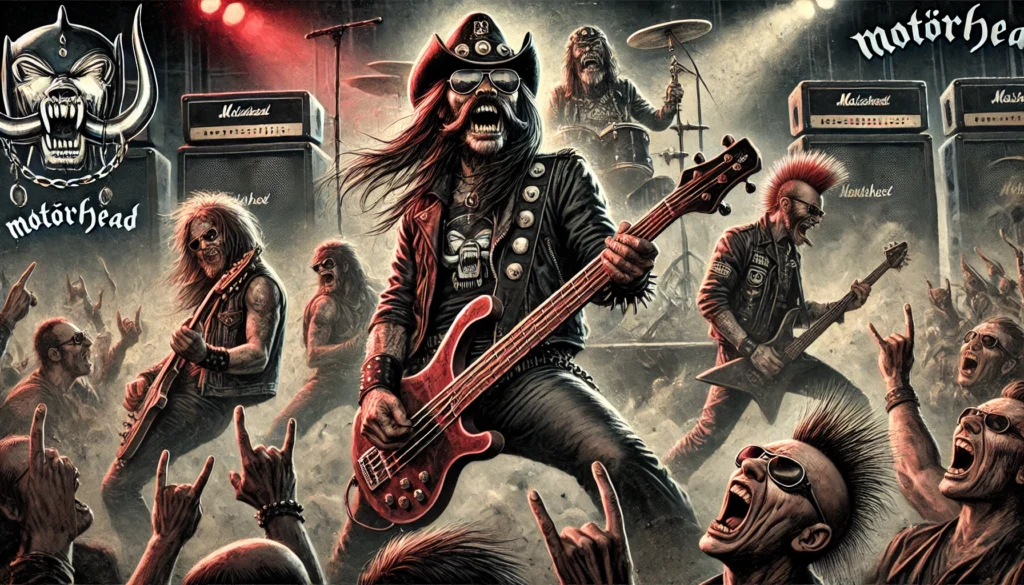
AI-generated image for illustrative purposes.
Ever notice how Motörhead never set out to be metal, and sure as hell didn’t care about being punk — yet somehow ended up defining the missing link between both worlds? Lemmy always swore his band was nothing more than loud, filthy rock ’n’ roll. But truth is, without meaning to, he wrote the sonic blueprint that fueled both extreme metal and the fastest strains of punk.
The Birth of Organized Chaos
While ’70s metal still carried the “epic” DNA of Deep Purple, Black Sabbath, and Led Zeppelin — and punk was exploding in London with its DIY attitude — Motörhead stormed onto the scene in 1975 spitting out a sound that didn’t fit any shelf.
Too fast for metal, too skilled for punk. Freshly kicked out of Hawkwind, Lemmy wasn’t interested in spacey experimentation anymore. What he wanted was noise, Jack & Coke, and pure speed.
The result? A sonic avalanche that had purists clutching their pearls.
Punk With a Turbo Engine
Motörhead was the first band to show punks that you could play faster, heavier, and still hold it all together. The anti-star stance, the stark black-and-white debut cover, and the raw aggression of tracks like “Motorhead” and “Iron Horse/Born to Lose” fit perfectly with the kids screaming their lungs out in London pubs.
The difference? Unlike most punk bands, Lemmy could actually play — and that mattered. His distorted bass sounded like a chainsaw ripping through every musical convention of the time.
Metal That Smelled Like Gasoline
At the same time, Motörhead slapped metalheads right out of their prog-rock comfort zone. The trio of Lemmy, Fast Eddie Clarke, and Phil “Philthy Animal” Taylor proved that metal could be simple, direct, and brutal without any frills.
Albums like Overkill (1979) and Ace of Spades (1980) didn’t just speed up heavy metal — they practically invented speed metal, planting the seeds for thrash.
No Motörhead? Then no Metallica with that fire, no Slayer on the edge of madness, and no Sepultura blasting doors off their hinges in the ’80s.
The Aesthetic of War
Another key element was the visual punch. While punks tore up jackets and metal bands embraced fantasy artwork, Motörhead carved out their own image with Snaggletooth — that fanged, chain-draped, helmeted demon-dog. It was cartoonish violence fused with real brutality, and it became mandatory on jackets and patches everywhere.
More than a logo, it was a manifesto: no posers allowed.
Punk, Metal, or Just Filthy Rock?
Lemmy never gave a damn about labels. He hated being called heavy metal and laughed at the idea of being punk. What matters is that Motörhead became the convergence point — showing punks that you could be heavy and showing metalheads that you could be fast.
That bridge birthed a whole new sonic continent. If punk was the spark and metal was the gas tank, Motörhead was the lit match that blew it all sky-high — always with a glass of Jack & Coke in hand.
Straight to the Bone
Motörhead proved you don’t need to choose between speed and weight, filth and skill. They proved rock can stay dangerous without boundaries. Too punk to be metal, too metal to be punk, and too rock ’n’ roll to care.
Or, in Lemmy’s immortal words:
“We are Motörhead. And we play rock ’n’ roll.”
And you — do you think Motörhead belongs more to punk, metal, or just pure chaos?
Burning Questions
Is Motörhead punk or metal?
Officially neither — Lemmy always insisted it was just rock ’n’ roll. But it’s a cornerstone influence on both.
Why is Ace of Spades so important?
Because it fused punk’s speed, metal’s weight, and Lemmy’s attitude into one definitive anthem.
What did Motörhead bring to metal?
Acceleration, simplicity, and brutality — the DNA of speed, thrash, and even death metal.
And to punk?
That you could be filthy, noisy, and still musically powerful — inspiring hardcore and crust generations.
By Tyler Wolf
👉 This is just one side of the story. What’s yours? Jump into the comments and join the debate.
